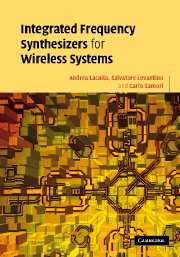5 - Noise in oscillators
Published online by Cambridge University Press: 09 August 2009
Summary
Introduction
The evaluation of the oscillator phase noise is a classical issue. Some of the fundamental papers date back to the 1960s [1–4] and recently the topic has received fresh attention as full integration of RF systems has become the focus of microelectronic design. Designers of VCOs had to rely on noise models either empirically explained or based on highly questionable linear small-signal analysis. Since clear guidelines for circuit optimization were lacking, design was mainly based on a trial-and-error approach. Only at the end of the 1990s was a deeper insight in VCO noise analysis gained. Two frameworks were proposed: one working in the time domain, [5–8] the other in the frequency domain. [9–11] They both succeeded in providing the first quantitative guidelines to noise optimization, linking phase-noise performance to the transfer of the noise sources in the circuit. This grounding is essential for later figuring out proper options and modifications of the circuit topology.
Accurate circuit-level simulators, which have been developed meanwhile, [12–14] simplify and speed up the proper tuning of design parameters and the noise performance evaluation in every operating condition.
This chapter is devoted to describing time-domain and frequency-domain methods for the oscillator noise analysis. Some examples of phase noise calculation based on these theoretical frameworks and verified against the circuit-level simulator results are also shown.
Linear and time-invariant model
The spectrum of real oscillators is far from being a δ-like function at the oscillation frequency ω0.
Information
- Type
- Chapter
- Information
- Integrated Frequency Synthesizers for Wireless Systems , pp. 103 - 132Publisher: Cambridge University PressPrint publication year: 2007
